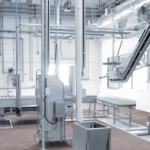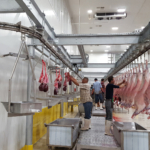
With advancements in automation, data management, and equipment, technology plays a pivotal role in enhancing efficiency, food safety, and animal welfare in abattoir design and processes.
This is an opinion piece or news article written by our staff.

The design of an abattoir is critical to ensuring the welfare of the animals and the safety of workers, as well as maintaining hygiene and efficiency. A well-designed abattoir can also help to reduce the stress and discomfort of the animals during the slaughtering process. In this article, we will discuss the aspects of good abattoir design.
Location
The location of an abattoir is crucial. It should be situated away from residential areas to minimize the impact of noise and odor. The site should also have easy access to transportation, such as roads and railways, to facilitate the movement of animals and meat products.
Layout
The layout of an abattoir should be designed to minimize stress on the animals and reduce the risk of injury to workers. The flow of animals should be arranged in a way that minimizes the distance and time they spend in the facility. The layout should also separate areas for different stages of processing, such as stunning, bleeding, and evisceration.
Equipment
The equipment used in an abattoir should be designed to be efficient, safe, and humane. This includes stun guns, hoists, and other equipment used to move and restrain the animals. The equipment should be easy to clean and maintain to ensure hygiene standards are met.
Lighting
Lighting is an essential aspect of abattoir design. The facility should be well-lit to ensure workers can see what they are doing, and the animals are not frightened by dark or dimly lit areas. The lighting should also be designed to minimize glare and shadows, which can cause confusion and distress to the animals.
Hygiene
Hygiene is critical in an abattoir to prevent the spread of disease and ensure the safety of meat products. The facility should be designed to allow for easy cleaning and disinfection. All surfaces should be smooth, non-porous, and resistant to corrosion. Drainage systems should be well-designed to ensure efficient removal of waste and prevent the build-up of bacteria.
Ventilation
Proper ventilation is necessary to maintain good air quality in the abattoir. The facility should be designed to provide adequate ventilation to remove heat, moisture, and odors. This can be achieved through a combination of natural and mechanical ventilation systems.
Safety
Abattoir design should prioritize the safety of workers and visitors. The facility should be designed to minimize the risk of accidents and injuries, such as slips, trips, and falls. All equipment and machinery should be well-maintained and have appropriate safety features.
In conclusion, good abattoir design is essential to ensure the welfare of animals, the safety of workers, and the hygiene and efficiency of the facility. The design should incorporate aspects such as location, layout, equipment, lighting, hygiene, ventilation, and safety to create a facility that is safe, efficient, and humane. A well-designed abattoir can help to improve animal welfare and meat quality while ensuring the safety and well-being of workers and consumers.

With advancements in automation, data management, and equipment, technology plays a pivotal role in enhancing efficiency, food safety, and animal welfare in abattoir design and processes.

Abattoirs play a critical role in this journey, serving as the gateway where livestock are transformed into meat products.

When it comes to abattoir operations, there are different models to consider, including small-scale and large-scale facilities.

Compliance with these regulations is essential to protect public health, maintain industry reputation, and adhere to legal requirements.